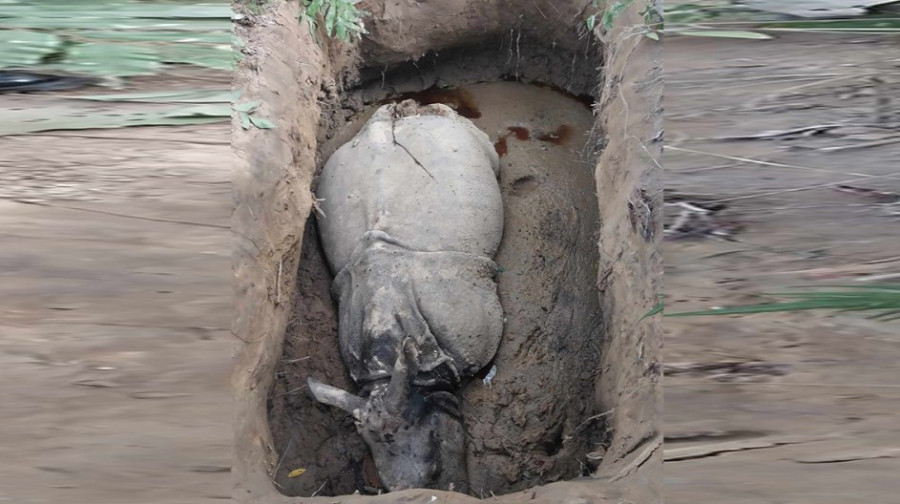Bagmati Province
Trap pits, electrocution resurface as threats to Chitwan’s rhinos
Chitwan National Park has reported three rhino killings in four months. But the park administration is clueless about the poachers involved or the horns’ whereabouts.
Ramesh Kumar Paudel
On Thursday, two female rhinos were found dead in separate man-made pits near the Chaparchuli security post at Sauraha in Chitwan National Park. Park officials said the rhinos, aged six and 18, were killed by poachers who made off with the animals’ horns, which are prized for their medicinal properties. The pits where the pachyderms were discovered dead are at a distance of around 150-metre from each other, according to park officials.
Poachers have apparently intensified their activities targeting one-horned rhinoceros in the park and its vicinity of late. The killing of rhinos in a trap of man-made pit and electrocution—which have resurfaced as security threats—has alarmed conservationists and security personnel.
Thursday’s discovery is not a one-off in the area this year. On August 31, park officials recovered a skeleton of a one-horned rhino in the same area. Conservationists and security personnel confirmed that poachers had killed the rhino as they could not find the animal’s horn.
The park administration on Friday said that poachers have killed three rhinos in its territory in the current fiscal year, which began on July 17. The administration, however, remains clueless about the poachers involved in the incidents and the horns’ whereabouts.
After celebrating zero poaching years for rhinos several times, incidents of rhino poaching are unchecked in recent years. On January 20, a female rhino and its calf were found dead on the bank of the Narayani river at ward 2 of Madhyabindu Municipality. The horn of the mother rhino had been severed. A postmortem confirmed that the rhinos died by electrocution. It took months for the authorities to nab the poachers. The Central Investigation Bureau of Nepal Police detained three poachers after four months. The horn is still not found.
These incidents show that the rhino poachers are active with new ways to kill the endangered species.
“The latest incident shows that rhino poachers are waiting for an opportune time and using whatever ways to kill the wildlife,” said Kamal Jung Kunwar, former chief conservation officer at the park. “It is a serious challenge for rhino conservation.” Kunwar suggested that the park administration should stay alert and intensify security patrols in the park area. “Strong intelligence mechanisms and participation of the local people are crucial to make conservation efforts effective,” he added.
According to the 2021 census, the population of one-horned rhino stands at 752 in the country. Chitwan is home to 694 rhinos, an increase of 89 since the last census in 2015.
The number of rhinos fell sharply in the 1950s and 60s but started to rebound after the establishment of the Chitwan National Park, the country’s oldest national park, in 1973. Rhino conservation suffered the worst during the decade-long armed conflict between 1996 and 2006 when 157 rhinos were killed. During the Maoist insurgency, the number of Nepal Army security posts went down from 38 to eight.
However, poaching incidents have drastically decreased since 2006 with the country celebrating zero poaching years for rhinos several times in the recent past. Zero poaching year means 365 days without a single rhino killed by poachers. Since achieving the first zero poaching year in 2011, the country has achieved the feat on six other occasions—in 2014, 2015, 2016, 2018, 2019 and 2020.
Natural death of the endangered species is also alarming in Chitwan. In recent years, rhino deaths caused by age, drowning, diseases and territorial clashes have increased markedly. Government records put rhino deaths into two broad categories—natural and poaching. All deaths, including those caused by territorial clashes, drowning, injuries, ageing and diseases, are defined as natural. Around 190 rhinos died of natural causes over the past eight years, the park administration has said.




 7.12°C Kathmandu
7.12°C Kathmandu1.jpg)












